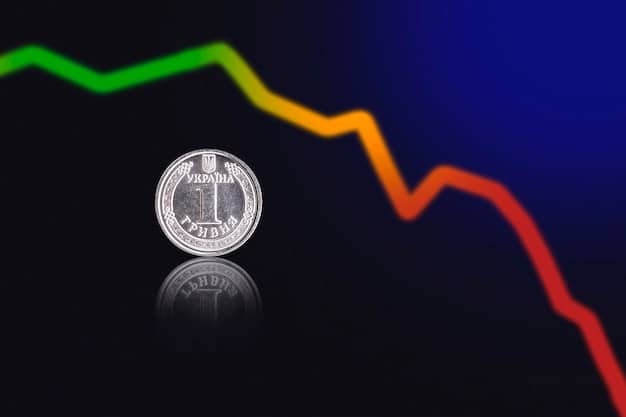Crypto Investing for Retirement: A Guide to Long-Term Portfolio Building in the US

Crypto investing for retirement presents a high-potential yet complex strategy for US residents aiming to grow their wealth over the long term, requiring careful consideration of risks, diversification, and regulatory factors to build a sustainable portfolio.
Planning for retirement can feel overwhelming, especially with economic uncertainties. The allure of high returns has led many in the US to consider **crypto investing for retirement**. But is it a sound strategy? Let’s delve into the world of digital assets and explore how you can potentially build a robust long-term portfolio.
Understanding Crypto’s Role in Retirement Planning
Cryptocurrencies have captured the attention of investors worldwide. However, incorporating them into a retirement plan requires a clear understanding of their nature and potential.
The volatility associated with cryptocurrencies cannot be ignored. This inherent risk profile needs to be carefully balanced against the potential for high growth.
The Allure of High Returns
One of the main drivers behind crypto’s popularity is its potential for high returns. Success stories of early adopters have fueled interest and optimism.
Understanding the Risks Involved
However, it’s essential to be aware of the potential pitfalls. Market fluctuations, regulatory uncertainties, and security risks all influence the stability of crypto assets.
- Volatility: Crypto markets are known for their extreme price swings.
- Regulation: The regulatory landscape for crypto is still evolving, adding uncertainty.
- Security: Crypto holdings can be vulnerable to hacking and theft.
Therefore, a prudent approach is crucial to manage these risks effectively. Understanding how these factors interact is key to aligning crypto investments with your retirement goals.

Setting Realistic Retirement Goals with Crypto
Before venturing into the world of digital assets for retirement, it’s vital to define your goals. This will help guide your investment decisions and risk tolerance.
Setting clear financial milestones is the first step in building a successful retirement portfolio. It should reflect a blend of aspirations and practicality.
Assessing Your Risk Tolerance
Your comfort level with market volatility plays a crucial role. Are you comfortable with the possibility of significant losses in exchange for potentially higher gains?
Defining Your Time Horizon
Retirement planning involves a long-term perspective. Consider how many years you have until retirement, as this will influence your strategy.
- Long-Term Growth: Aim for sustainable gains over the long term.
- Diversification: Don’t put all your eggs in one basket.
- Regular Monitoring: Keep track of your portfolio and make adjustments as needed.
Careful consideration of your risk tolerance and timeline is the foundation for a responsible and effective crypto investing strategy.
Choosing the Right Cryptocurrencies for Long-Term Growth
The cryptocurrency market is filled with numerous options, each with different characteristics and potential. Selecting the right assets for your retirement portfolio is crucial.
Focus on established cryptocurrencies with clear use cases and strong community support. This typically translates to increased stability and growth potential.
Bitcoin (BTC): The Benchmark
As the first cryptocurrency, Bitcoin remains a dominant force. Its store-of-value narrative makes it an appealing option for long-term investors.
Ethereum (ETH): The Smart Contract Giant
Ethereum’s smart contract capabilities have paved the way for decentralized applications. Its versatility makes it a valuable addition to any portfolio.

Choosing the right mix of stablecoins, DeFi tokens, and emerging altcoins can further optimize your portfolio. However, diversification is key to protecting your assets.
Building a Diversified Crypto Retirement Portfolio
Diversification is a cornerstone of any sound investment strategy, and it’s particularly important in the volatile world of cryptocurrencies.
Spread your investments across different crypto assets and sectors. This will help mitigate risk and improve overall portfolio stability.
Asset Allocation Strategies
Consider factors such as market capitalization, use cases, and risk levels when allocating your assets.
Rebalancing Your Portfolio
Regularly review and adjust your portfolio to maintain your desired asset allocation. Market conditions can change rapidly, so it’s important to stay proactive.
- Assess Market Trends: Stay on top of market developments and news.
- Adjust as Needed: Rebalance your portfolio based on prevailing conditions.
- Stay Disciplined: Avoid impulsive decisions driven by market hype or fear.
Implementing a well-thought-out asset allocation strategy and maintaining a disciplined approach to rebalancing is key to success.
Tax Implications of Crypto Investing for Retirement in the US
Understanding the tax implications of crypto investing is critical for US residents. Navigating the complex crypto tax landscape will avoid unwanted surprises.
Crypto transactions are generally treated as capital assets by the IRS. This means they are subject to capital gains taxes when sold.
Capital Gains vs. Ordinary Income
Differentiate between short-term capital gains (held for one year or less) and long-term capital gains (held for more than one year). Rates vary depending on your income bracket.
Tax-Advantaged Retirement Accounts
Consider using tax-advantaged retirement accounts like Roth IRAs or Solo 401(k)s to hold your crypto investments. This can offer significant tax benefits.
- Professional Advice: Consult a tax advisor for personalized guidance.
- Accurate Records: Maintain thorough records of all crypto transactions.
- IRS Guidelines: Stay updated on the latest IRS regulations regarding crypto.
Staying informed and compliant with US tax regulations is crucial for optimizing your crypto investments for retirement.
Secure Storage Solutions for Your Crypto Retirement Funds
Protecting your crypto assets from theft and loss is paramount. Implementing robust security measures ensures the safety of your retirement funds.
Choose a secure storage method that aligns with your risk tolerance and technical expertise. Options range from hardware wallets to custodial solutions.
Hardware Wallets
Hardware wallets offer a high level of security by storing your private keys offline. This reduces the risk of hacking and malware attacks.
Custodial Solutions
Custodial solutions involve entrusting your crypto to a third-party provider. While convenient, this carries the risk of potential loss due to hacks or mismanagement.
- Two-Factor Authentication: Enable 2FA on all your crypto accounts.
- Strong Passwords: Use unique and complex passwords.
- Cold Storage: Consider storing a significant portion of your assets offline.
Prioritizing security is critical for safeguarding your crypto retirement funds and ensuring long-term peace of mind.
| Key Point | Brief Description |
|---|---|
| 💰 Goal Setting | Define clear financial milestones for your retirement. |
| 📊 Diversification | Spread investments across different crypto assets. |
| 🔒 Secure Storage | Use hardware wallets or secure custodial solutions. |
| Tax Planning | Understand and comply with US tax regulations. |
Frequently Asked Questions
▼
Crypto investing involves risks due to market volatility and regulatory uncertainties. However, with careful planning, diversification, and risk management, it can be a part of a retirement strategy.
▼
The percentage depends on your risk tolerance and time horizon. Financial advisors often recommend allocating a small portion, such as 5-10%, to crypto, especially when approaching retirement age.
▼
Established cryptocurrencies like Bitcoin and Ethereum are often considered safer choices. They have demonstrated long-term potential, but it’s important to stay informed about emerging trends and technologies.
▼
The IRS treats crypto as property, subjecting it to capital gains taxes. Short-term and long-term gains are taxed differently, so maintaining accurate records is crucial. Consult with a tax advisor for personalized guidance.
▼
Hardware wallets offer offline storage for enhanced security. Custodial wallets provided by exchanges are convenient but come with inherent risks. It’s crucial to balance convenience with robust security measures.
Conclusion
Incorporating crypto into your retirement plan can be a compelling way to pursue higher returns, but it’s essential to approach it with caution and a well-informed strategy. By fully understanding the risks, diversifying your portfolio, and staying updated on regulations, you can make sound decisions that align with your long-term financial goals.





